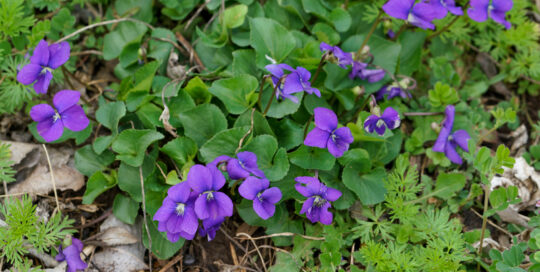Lichens indicate a healthy environment
Views: 3574
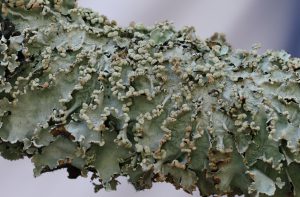
Lichens are unique organisms and having them in your yard and garden is a good sign: they are extremely sensitive to pollution and harmful chemicals, so their presence is a good indicator of a healthy environment. This was just one of many things I learned on a “lichen walk” at Oxley Nature Center in Tulsa, Oklahoma last month.

There are multiple species of lichen in this photo. Their presence is a good indicator of good environmental air quality.
The Oklahoma Native Plant Society hosted this educational walk, and I knew I had to go. I’ve always been interested in lichens, one of the more common examples of natural symbiosis, but I learned a lot more about them on this hike. The scientific vocabulary associated with lichens was tough to follow in the field, but hopefully I’ll do a better job relaying the information here in writing.
What are lichens?
While appearing to be somewhat plant-like, lichens are actually composed of fungi and algae living together like cats and dogs in total, peaceful harmony. (Actually, fungi and algae aren’t even in the same biological kingdoms, so cats and dogs are much more closely related than these two cohabiters, but I digress.) To be more precise, most lichens are composed of fungal filaments surrounding algal cells from either a green alga and/or blue-green alga (cyanobacterium). The algae/bacteria provide photosynthesis while the fungi provide a degree of protection from the elements, such as drought, so the relationship is mutually beneficial. Fungal structures called rhizines attach the lichen to a surface (officially called a substrate) such as a rock, tree, or soil.
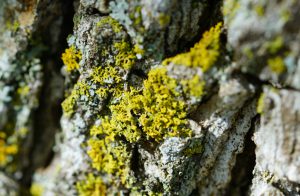
Lichens do not have roots.
Lichens get their nutrients directly from air and water. They don’t have roots like plants nor specialized internal structures to move food or water through their bodies. Everything they need is produced via photosynthesis or direct absorption. Because they have no means of filtering out harmful substances, they are very sensitive to environmental toxins. In fact, lichens are sometimes used to monitor air pollution.
Lichens grow when they get enough water and light. When they don’t get enough water, they go dormant. Without enough light, they eventually die. When they get everything they need, they can live for years; in fact, they may be some of the oldest living things on Earth.
Types of lichens
There are many thousands of different species of lichen (as many as 20,000 according to various websites), and most of them can be classified into four different forms:
- Crustose – Crust-like lichens that grow very tightly to their substrate with few protuberances or tendrils
- Foliose – Leaf- or lettuce-like lichens that grow in flat sheets
- Fruticose – Tube- or branch-like lichens that hang or stick up from their substrates
- Squamulose – Pebble-like lichens that are similar to crustose lichens, but more isolated individually so they don’t form a single, solid sheet, but rather a dotted one
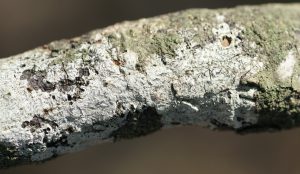
Crustose lichens form a crust on their substrate. This is probably Graphis scripta.
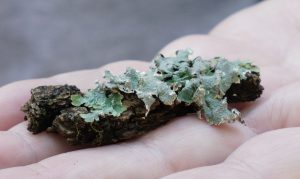
Foliose lichens have leaf-like growth. This is probably a Punctelia.
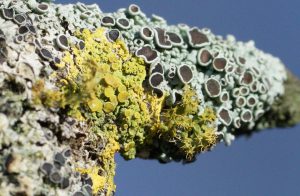
The orange lichens in this photo may be fruticose lichens, possibly Candelaria and/or Teloschistes.
Lichens come in many colors, including varying shades of green, blue-gray, black, brown, orange, and red. They tend to become more vibrant when wet and much duller when dry.
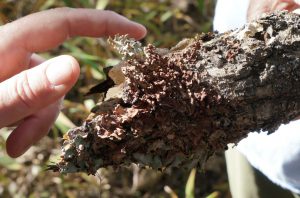
This foliose lichen has turned brown, probably because it is dry.
Lichen reproduction
Lichen reproduction is a complicated affair since two different species are involved. While the fungi can produce fruiting bodies that can release spores into the environment, unless the spores find an algal/bacterial partner, they won’t be able to produce another lichen. Non-sexually, bits of lichen can break off the main host to become their own individual entity at another location. For more details on lichen reproduction, check out this explanation.
Lichens in the garden
This is just a short introduction to the fascinating world of lichens. After the hike, I came home to see if I could find any lichens in my yard. I didn’t find any, and that was disappointing. I did locate some deep in the woods behind my property, but none up close. Without harming the main organism, I may try to break off some tiny bits this spring to see if I can get some growing on my concrete birdbath or the rocks around my pond. It would be nice to have a barometer of good health in my gardens.
For more information, these are good websites:
Meet Leslie Miller
Leslie Ann Miller shares 3.5 acres in rural Oklahoma with birds, butterflies and wide variety of animals. She is currently transforming her yard with plantings…
Leslie's Recent Posts

Early spring is time to plant native spring ephemerals
